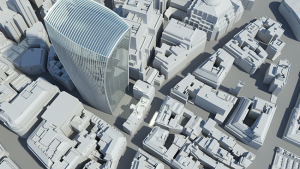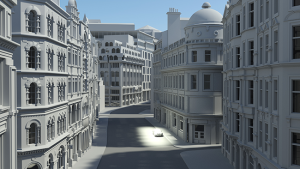While today’s sleek skyscrapers filling urban landscapes seem to embody modern and cutting-edge design, it’s often not until after these mammoth structures are built that hidden design flaws rear their ugly heads, sometimes with rather dire consequences.
In one particular case, these consequences included a building that was quite literally melting nearby cars.
London’’s year-old 20 Fenchurch Street tower is a stunner, but the same curved glass that gives the 37-storey tower the nickname, “The Walkie Talkie,” also has a knack for concentrating sunlight.
London’’s year-old 20 Fenchurch Street tower is a stunner, but the same curved glass that gives the 37-storey tower the nickname, “The Walkie Talkie,” also has a knack for concentrating sunlight.
The result of which is a hot spot that melted part of a nearby black Jaguar XJ and cooked shampoo in a local barber shop. It’ has even been used to fry eggs.
Such “death rays” are growing problem, thanks to a new generation of glass-sheathed buildings with radical computer-designed curves. Those curves reflect — and concentrate — light in ways that have been hard for designers and engineers to predict.
At the recently held GPU Technology Conference, NVIDIA’ used the power of its GPUs to demonstrate how London’’s fifth-tallest building came to be known as the “”Fryscraper.”” The reality is that the Walkie Talkie building’’s solar glare could have been worse. If the building’’s curves were altered, even slightly, it could have created a beam of light hot enough to melt lead.
And Iray We Go
Rendering–the process of turning a digital model into an image on a screen–isn’’t new. Neither is ray tracing, which tracks the way beams of light interact with objects in their environment. What’ is new, however, is how the company’s Iray ray tracing technology takes advantage of GPUs to render detailed models in real-time.
Rather than relying on technology that takes hours to create a single, static image, or a snapshot, designers, using Iray, can view digital images as they work. They can see how light interacts with their design over long stretches of time–as the sun moves across the sky at different times of the day and year–rather than just a moment or two.
NVIDIA is developing plug-ins that will integrate this capability into the most popular design tools, putting this capability into the hands of most designers, something that can save time and potentially avoid trouble down the line.
Real-time raytracing can help identify hidden design flaws
I saw for myself the power of real-time raytracing rendering at a Dassault Systèmes’ 3DEXPERIENCE event late last year. During one session a fully interactive visualization of a Honda car was shown. The demo didn’t just show a spinning digital prototype–which we’ve all seen before–but showed how a whole section of the vehicle could be “peeled” away in real-time to show specific components, down to the electrical wires and seat springs. It was fascinating.
Technology like this promises to solve a huge number of common design problems as well as some that aren’’t so common.

A new generation of glass-sheathed buildings with radical computer-designed curves have created some unexpected challenges for designers and some unexpected results.
The challenges of modeling light
Factoring in the effects of reflected light into design is something that’s traditionally been challenging for designers, and yet today’s highly stylized buildings often require it. Building structures without taking the effects of light can have disastrous results.
Take 20 Fenchurch, for example.– Its glass curves create a spot where the temperature can rise to almost 200 degrees Fahrenheit. The Vdara Hotel, just off the Las Vegas Strip, with –its concave glass facade, creates temperatures by the pool hot enough to melt plastic and have caused guests to get extreme sunburns. Or L.A.’’s extravagant Walt Disney Concert Hall. It heated up nearby condos, driving residents to draw their shades and run air conditioners.
None of this is the work of mad scientists or James Bond-style villains. The structures were created by architects and engineers who lacked the tools to predict how their designs will interact with the world around them.
In the past, modeling reflected light has been a time-consuming procedure that is usually reserved for presentations of near-final designs. Designers build those presentations around specific lighting conditions; they’’re snapshots, not simulations.

NVIDIA’s new Iray technology enables designers to model light in ways that were previously not practical.
Quadro M6000 graphics cards deliver the horsepower for high-res visualizations
NVIDIA’s new Iray 2015 rendering technology changes that. When paired with the new Quadro M6000 graphics card, reportedly the world’s most powerful GPU, –Iray 2015 models the way light bounces around a scene as design teams tweak their models.
What makes it even better is that it can be done very quickly. Rather than having to wait hours to create photorealistic images, designers can just add more GPUs to create higher-resolution models in an instant. NVIDIA’s upgraded Quadro Visual Computing Appliance (VCA) features a whopping eight Quadro M6000 GPUs.
Adding the VCA to a data center enables design teams to tap its rendering power when and where it’s needed. Every NVIDIA Iray product will include the ability to stream rendering from machines running its Iray Server software. NVIDIA will make Iray accessible to users with add-ins for popular 3D applications, such as Autodesk’s 3ds Max, Maya, and Revit, McNeel Rhinoceros and Maxon Cinema 4D.
With this new generation of prototyping tools, designers and engineers will no longer have to build detailed physical models or create movies of rendered objects. Instead, designers will be able to see their work in real-time, which can save months or years. And, possibly save a few Jaguars from the next “fry scraper.”
Comments
Post a Comment